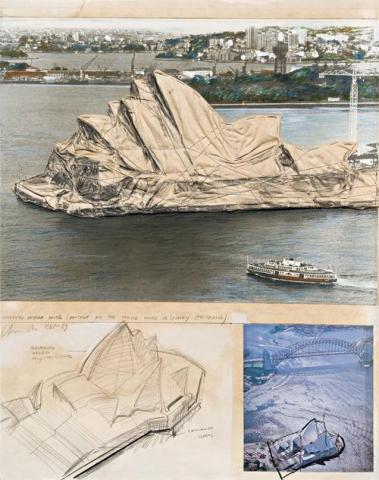WRAPPED SYDNEY OPERA HOUSE, 1969
Christo
fabric, staples, string, photographs, pencil, crayon and bodycolour on card on board
71.0 x 56.0 cm
signed and inscribed centre left: WRAPPED OPERA HOUSE (PROJECT FOR THE OPERA HOUSE IN SYDNEY AUSTRALIA) / Christo 1968-6
Possibly Barry Stern Gallery, Sydney
Private collection, New South Wales
Christo - Sydney: The John Kaldor Project, Art Gallery of New South Wales, Sydney, September 1990 (label attached verso)
‘…Throughout the millenniums, for thousands of years artists have tried to input into their works of art a variety of different qualities. They have used different materials… they have created abstract images, figurative images, religious images, profane. They have tried to do bigger, smaller, a lot of different qualities. But there is one quality they have never used, and that is the quality of love and tenderness that we human beings have for what does not last… That quality of love and tenderness, we wish to donate it, endow our work with it as an additional aesthetic quality. The fact that the work does not remain creates an urgency to see it… For instance, if someone were to tell you, “Oh look, there's a rainbow ”, you would never answer, “I will look at it tomorrow.”’1
Although bearing affinities with a number of artistic precedents, from Constructivism and Nouveau Réalisme to happenings and land art, and even the draped figures of antiquity, Christo's vision is truly unique in its reconsideration of the permanent through creations which are temporary by design. Fundamental to this aesthetic is the use of fabric as an agent for transformation and revelation; the wrapping or surrounding of familiar objects, the intervention of fabric where one least expects, not only undermines our comfortable residence with the accustomed, but creates an uneasy sense of dislocation. Not withstanding such ambivalence however, this draping or veiling action does not dissolve the known - to the contrary, it recontextualises and reveals it further, serving as a mediator between our pre-existing conceptions and inferences of shifting states. Notably, the first of such large-scale wraps occurred in Australia in 1969 when art patron John Kaldor invited Christo and his wife Jeanne-Claude to wrap the coast of Sydney's Little Bay. A highly controversial project encompassing over one million square feet, the sculpture launched Christo's career on the international stage, and indeed, heralded a new chapter of contemporary art in Australia, leaving artists such as Imants Tillers and Ian Millis who worked as volunteer labour, indelibly influenced by the experience. Predictably however, the project also attracted vehement condemnation within the then conservative local community, and thus, plans to subsequently wrap the Sydney Harbour Bridge and newly-unveiled Opera House were abandoned. With the artist considering the extensive preparatory process as important as the actual installation, the present Wrapped Sydney Opera House is thus especially valuable, offering a rare glimpse into the artist's aspirations and prompting contemplation of the issues and uncertainties which such an installation might have raised.
1. Jeanne-Claude cited in ‘An interview with Christo and Jeanne-Claude’ at http://christojeanneclaude.net/eyeLevel.html
VERONICA ANGELATOS
